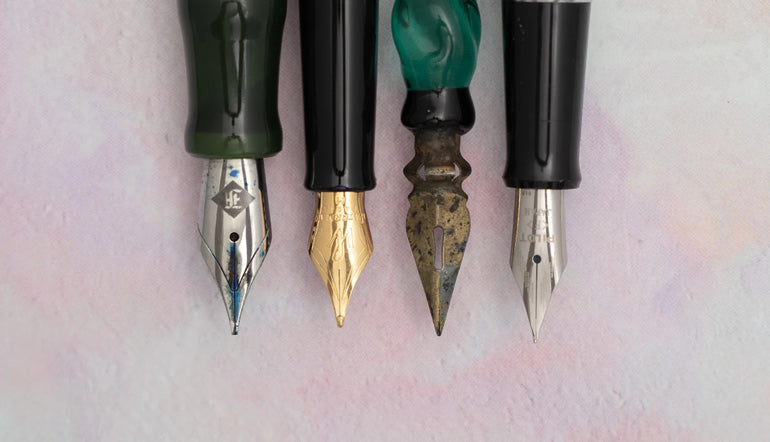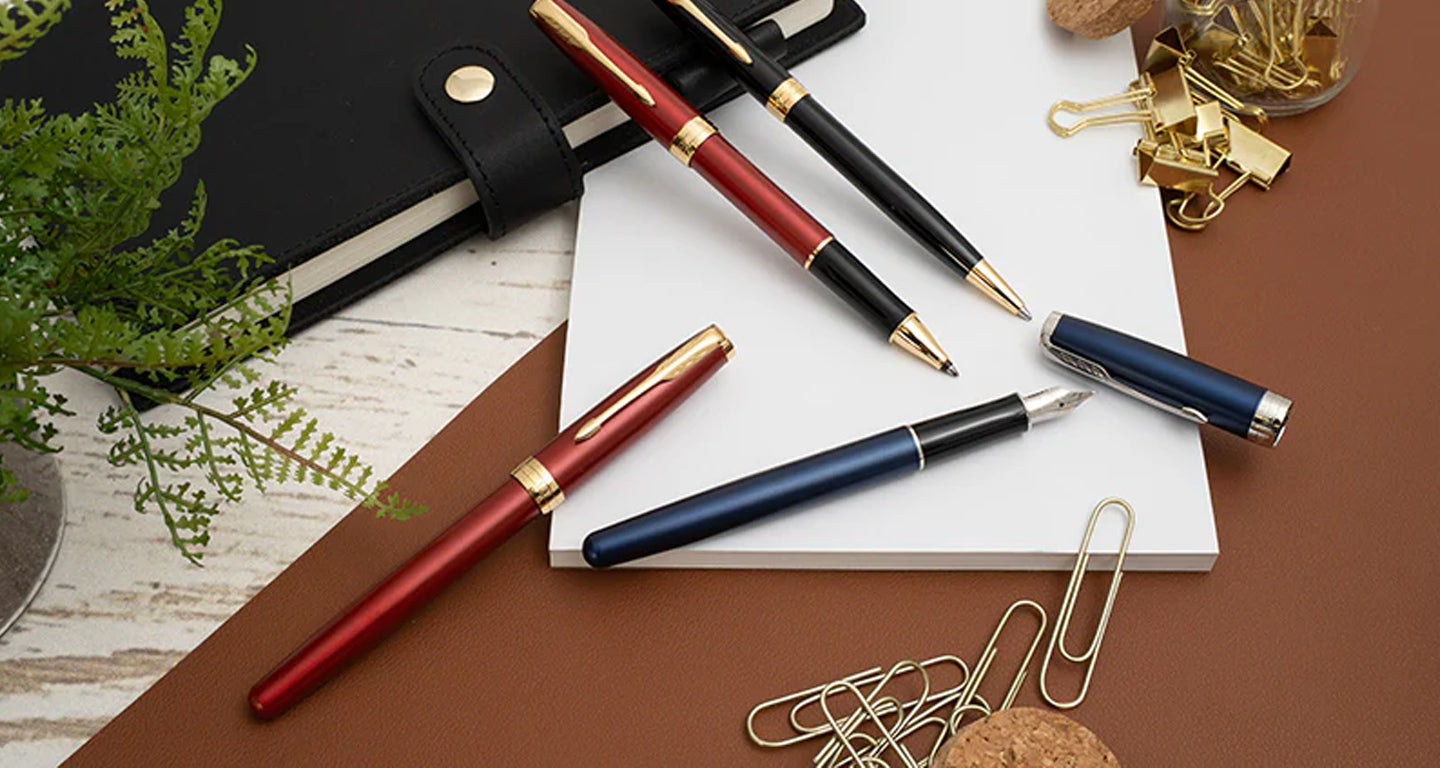
What is a Fountain Pen Nib
The question, "what is a fountain pen nib?” can seem like a strange one. It’s almost like asking someone to define a fountain pen—it’s a common item, but nobody really gives it much thought to have a definition ready at hand.
In this article, I am going to give you more than a definition. I’ll go over various aspects of a fountain pen nib including:
- Parts of a nib and their functions
- History of the fountain pen nib
- Different types of fountain pen nibs
- How to clean your fountain pen nibs
Let’s go on a journey to discover what makes the types of fountain pen nibs so fascinating and important to the functioning of fountain pens.
What is a Fountain Pen Nib?
Use Your Own Dayspring Pens Nib Today
A fountain pen nib is the point of a fountain pen where the tip touches the writing surface.
What makes the nib so different from the writing tip of a ballpoint or rollerball is the shape.
Like the reed and quill pens of yore, the nib is a piece of metal, shaped to a point and split from the tip to the center of the structure to create tines.
The tines channel the ink down to the point and allow for movement and flexibility while drawing the pen across the paper.
To make sense of all the parts, let’s look at the anatomy of the nib.
Anatomy of a Fountain Pen Nib

The Body
Simple enough, the body is the composite whole of the nib.
The Slit
A slit starts from the point of the body to the area where the metal flanges out.This creates the tines and draws ink from the fountain pen feed to the nib tip.
The Tines
Two flexible metal prongs called tines extend from the tip to the base of the nib. The tines control the rate of ink flow onto the paper depending on their shape and flexibility.
The Breather Hole
On one end of the slit lies the breather hole, which regulates air pressure within the ink reservoir as the ink flows out during writing.
The Shoulders
From the tip, the tines widen towards the base to form the shoulders. This is where the sturdiness of the nib comes from, helping to ensure proper alignment of the tines as you write.
The Tip
The piece of metal alloy at the end of a nib is known as the tip. It enables the nib to withstand the friction of being in contact with the paper.
So where did this unique looking writing point come from?
History and Evolution of the Fountain Pen Nib
The term nib originates from roughly the end of the 1500 to the beginning of the 1600s and referred to the two split tines of the end of a quill that looked like the beak of a bird. (Nib was another word for nose or beak.)
These nibs were always made by expertly cutting a quill into a writing tip with a pen-knife, and were sometimes even attached to metal pens.
| Learn More: Discover the whole history of the fountain pen |
Quill nibs needed to be constantly reshaped and mended, so even though they were very effective, they were demanding.
By the 1800s Mass manufacturing allowed steel nibs to be made cheaply, which counteracted how ineffective steel nibs were (they corroded quickly and were very rigid making them difficult to write with).
Gold became the desired material since it was non corrosive to fountain pen ink and flexible.
Unfortunately as a soft metal, gold could not withstand the necessary wear and tear of writing until the iridium tipped gold nib was developed in 1834.
The last major change to the nib came from an English journalist, James Perry, who introduced a hole at the top of the nib slit in 1830, improving the flexibility of the nib and regulating how fast ink flowed onto the paper.
Now let’s explore the materials that nibs are made of.
3 - Different Types of Nib Materials
The most common fountain pen nib materials are stainless steel, gold, and iridium.
Most entry-level fountain pens have stainless steel nibs, which makes them affordable and durable, standing up well against the wear and tear of daily use.
High-end pens often have gold nibs.
Being a softer metal, gold allows such nibs to move with greater flexibility than their stainless steel counterparts.
Iridium, a hard noncorrosive metal, is used as a tipping metal that is soldered or welded onto the end of the nib before the slit is cut.
4 - Nib Widths and Their Uses
Types of fountain pen nibs
Let’s look at each type in detail.
Broad Nibs
These types of nibs produce wide lines, making them excellent for signatures.
If you enjoy more bold, expressive writing, broad nibs are a good choice. They also show off ink properties such as sheen and shimmer well.
Medium Nibs
Offering a balance between line width and smoothness, medium nibs work well for both writing and drawing.

Fine Nibs
People with a small handwriting will find fine nibs to be most appropriate for them since they don’t lay down too much ink which obscures lettering.
Extra Fine Nibs
For intricately detailed work such as fountain pen drawings, technical drawings, and calligraphy, extra fine nibs give the best results.
Fun Fact: Fountain pens from Japanese manufacturers such as Pilot have slightly different nib sizing because of the writing system that features super detailed characters. As such, Japanese fountain pens have finer, more precise tips than those from Western companies.
Italic Nibs
Italic nibs are ground flat. This produces a thin downstroke and a broad cross stroke, perfect for calligraphy and ornate writing that uses varying line widths.
Flex Nibs
These are nibs with a non-rigid structure which allows the tines to separate easily while writing. With more pressure, the tines spread out while reduced pressure lets them remain together.
In the following table, see the properties of different types of fountain pen nibs:
| Nib Type | Line Width | Characteristics | Best Suited For |
| Broad | Wide | Shows ink sheen and shimmer well, accommodates large handwriting | Calligraphy, decorative writing, signatures |
| Medium | Moderate | Compromise between boldness and precision | Note-taking, journaling, handwriting practice |
| Fine | Thin | Clean and precise strokes, great for small handwriting | Annotations, technical drawings, details in artwork |
| Extra Fine | Super thin | Precise strokes, long ink life span | Sketching, intricate designs |
5 - Caring for Your Fountain Pen Nib
For your fountain pen to remain in great working condition, it’s important to take good care of it. The nib, especially, needs TLC because it’s the most delicate part of the pen.
Experience a Cross Fountain Pen
Cleaning Your Fountain Pen Nib
Cleaning a nib is pretty easy, the basic idea being flushing out the ink that’s in the pen using clean water.
Flushing With Plain Water
- Expel as much ink from your pen as you can, either back into the ink bottle or down your sink drain.
- Fill the ink reservoir with clean water then flush it out.
- Repeat until the water runs clear. If you’ll be changing your ink color, ensure you remove all of the old ink to avoid problems with the two colors mixing.
- Using a soft cloth, soak up excess water through the nib. Don’t worry about small water droplets remaining in the pen if you’ll be filling it with ink soon. Fountain pen ink is water based and a few drops won’t cause any issues.
Expert Tip: If you’ll not be using your fountain pen for a while, let it sit uncapped for a few hours to allow it to dry completely before storing the fountain pen.
Water and Dish Detergent
In case the ink has dried out or you have used an ink with intensely saturated color, dish detergent is an excellent solution.
Simply add a drop of detergent to a glass of water and repeat the above method until all the ink clears from the pen.
Using a Bulb Syringe
For cartridge/converter fountain pens, this method makes cleaning the fountain pen nib such a breeze. A bulb syringe helps to push water through the section far more effortlessly than using a converter.
To clean your pen, attach the syringe to the back of the grip then press the syringe gently. This will flush water through the section and nib.
Conclusion
A fountain pen nib is more than just the part that deposits ink onto the paper. It’s the most important element of the pen, and understanding how it works will bring delight into your writing experience.
Do you have a favorite fountain pen nib or two? Tell me all about them in the comment section below.
|
Sam Di Nardo is an author for Dayspring Pens, where she has honed her expertise in ballpoint, rollerball, gel and fountain pens since joining the team in 2018. From her initial role as an Engraver to becoming the Production Manager, Sam's journey has been marked by her passion for the history, manufacturing, and the unique value of gifted writing instruments. A graduate of Regent University with a degree in English Literature and a special interest in Old Norse literature, dive deeper into Sam's world and discover why she's your trusted guide in the realm of gift pens. |
Share






